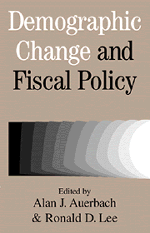Book contents
- Frontmatter
- Contents
- List of Figures
- List of Tables
- Contributors
- Acknowledgments
- 1 Introduction
- 2 Population Forecasting for Fiscal Planning: Issues and Innovations
- 2-1 Comment
- 2-2 Comment
- 3 Uncertainty and the Design of Long-Run Fiscal Policy
- 3-1 Comment
- 3-2 Comment
- 4 How Does a Community's Demographic Composition Alter Its Fiscal Burdens?
- 4-1 Comment
- 4-2 Comment
- 5 Social Security, Retirement Incentives, and Retirement Behavior: An International Perspective
- 5-1 Comment
- 5-2 Comment
- 6 Aging, Fiscal Policy, and Social Insurance: A European Perspective
- 6-1 Comment
- 6-2 Comment
- 7 Demographics and Medical Care Spending: Standard and Nonstandard Effects
- 7-1 Comment
- 8 Projecting Social Security's Finances and Its Treatment of Postwar Americans
- 8-1 Comment
- 9 Demographic Change and Public Assistance Expenditures
- 9-1 Comment
- 9-2 Comment
- Index
3 - Uncertainty and the Design of Long-Run Fiscal Policy
Published online by Cambridge University Press: 03 February 2010
- Frontmatter
- Contents
- List of Figures
- List of Tables
- Contributors
- Acknowledgments
- 1 Introduction
- 2 Population Forecasting for Fiscal Planning: Issues and Innovations
- 2-1 Comment
- 2-2 Comment
- 3 Uncertainty and the Design of Long-Run Fiscal Policy
- 3-1 Comment
- 3-2 Comment
- 4 How Does a Community's Demographic Composition Alter Its Fiscal Burdens?
- 4-1 Comment
- 4-2 Comment
- 5 Social Security, Retirement Incentives, and Retirement Behavior: An International Perspective
- 5-1 Comment
- 5-2 Comment
- 6 Aging, Fiscal Policy, and Social Insurance: A European Perspective
- 6-1 Comment
- 6-2 Comment
- 7 Demographics and Medical Care Spending: Standard and Nonstandard Effects
- 7-1 Comment
- 8 Projecting Social Security's Finances and Its Treatment of Postwar Americans
- 8-1 Comment
- 9 Demographic Change and Public Assistance Expenditures
- 9-1 Comment
- 9-2 Comment
- Index
Summary
Introduction
Over time, the share of federal government expenditures tied to agerelated programs, particularly those focusing on the elderly, has grown rapidly. For example, U.S. spending on Social Security (OASDI) and Medicare alone has risen from 15 percent of the federal budget in fiscal year 1966 (the year of Medicare's introduction) to 35 percent in fiscal year 1998 and is projected to grow to 44 percent of the federal budget during the next decade (Congressional Budget Office 1998). Combined with the changing composition of the U.S. population, this change in spending composition has led to serious questions about the viability of current fiscal policy, both in the United States and abroad (e.g., Auerbach et al. 1999).
Dealing with the apparent fiscal imbalances associated with aging populations raises difficult questions about how and when to change policy. Projected long-term cash-flow imbalances are so large that significant immediate adjustments appear necessary to avert serious economic problems. However, with considerable uncertainty about how serious future cash-flow imbalances will be, there is also a natural tendency to put off dealing with problems that might not materialize. This tendency is magnified by the perception that old-age transfer programs, particularly Social Security, are a “third rail” of American politics, and a sense that a change today may make it harder to alter the system tomorrow.
- Type
- Chapter
- Information
- Demographic Change and Fiscal Policy , pp. 73 - 92Publisher: Cambridge University PressPrint publication year: 2001
- 6
- Cited by



